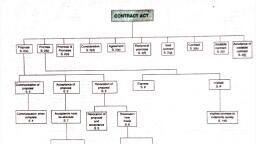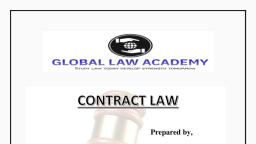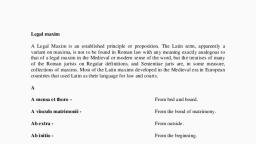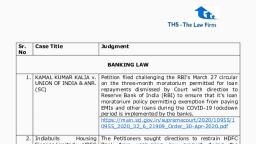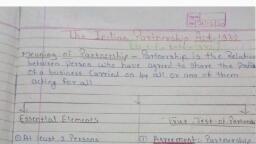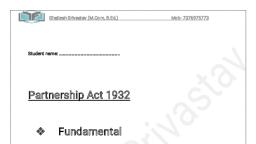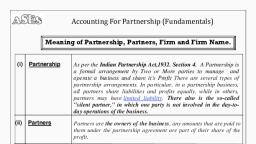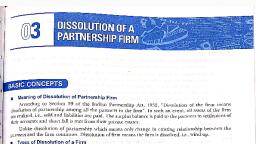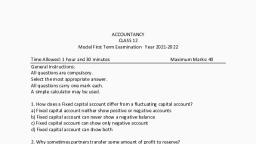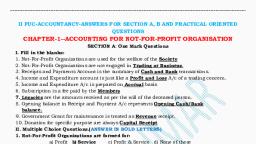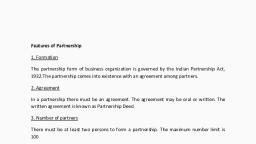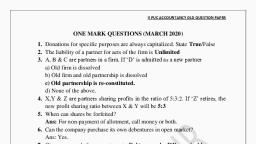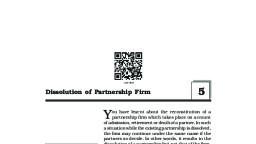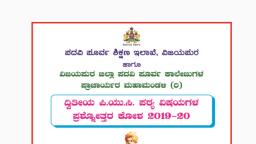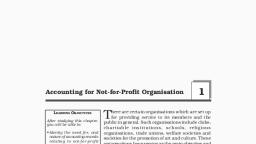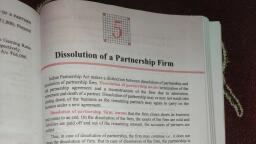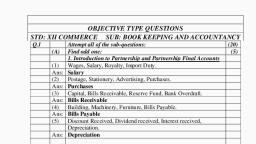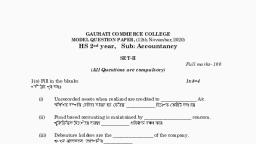Page 2 :
DEFINITION, • According to sec. 4 of the Indian Partnership Act, 1932 “Partnership”, is the relation between persons who have agreed to share the profits of, a business carried on by all or any of them acting for all., , •, •, •, •, , Partners, firm, Firm Name, Partners :Person entered into partnership individually, Firm : Collectively a firm, , Firm Name : The name under which the business is carried
Page 3 :
COMMENCEMENT, • Received the assent of the Governor-General on 8th April 1932., • Came into force on the 1st day of October, 1932.
Page 4 :
ESSENTIAL ELEMENTS OF A, PARTNERSHIP, •, •, •, •, •, , a.) There must be a contract., b.) Between two or more persons., c.) Who agree to carry on business., , d.) With the object of sharing profits., e.) The business must be carried on by all or any of them acting for all
Page 5 :
FORMATION OF PARTNERSHIP, • Agreement: orally, written or may be implied, • Must be free and genuine consent, • Object should be law full and complied with legal formalities.
Page 6 :
KINDS OF PARTNERSHIP, PARTNERSHIP, , PARTNERSHIP, AT WILL, , PARTICULAR, PARTNERSHIP
Page 7 :
CONTD.., • Partnership at will: Where no provision is made by contract between, , the partners for the duration of their partnership, the partnership is, ‘partnership at will.’ The essence of a partnership at will is that the, partners do not fix any term of partnership and are free to break their, relationship at their own sweet will. It is a partnership for an indefinite, period., , • Particular partnership: When a partnership is formed for a particular, , period or for a particular venture, it is called particular partnership. In, such a case, the partnership is automatically dissolved at the expiry of, the fixed term or on the completion of the venture.
Page 8 :
CLASSES OF PARTNERS, Actual or Active Partner, • Engaged in actual conduct of the business, • His acts binds the firm and other partners, • Notice to be given in case of retirement, Sleeping or Dormant Partner, • Does not take part in the conduct of business, • Contributes his share of capital and enjoys profits and losses, • Not known to outside world, • Not liable to third parties for the acts of the firm, • Not required to give notice in case of retirement
Page 9 :
CONTD.., Nominal Partners, , • No real interest in business, Does not contribute any capital, Lends his, name only, , • No share in profits but liable to third parties for all acts of the firm, Partner in Profits only, , • Shares the profits but not losses, • No interest in the management of the firm, • Liability for the acts of the firm is unlimited
Page 10 :
RIGHTS OF PARTNERS, •, •, •, •, •, •, •, , Right to take part in the conduct of the business, , Right to be consulted., Right to access the books., Right to share the profits., Right to interest on capital, Right to interest on advances., , Right to indemnity.
Page 11 :
INCOMING AND OUTGOING, PARTNERS, • No partner can be admitted as a partner into a firm without the, consent of all the existing partners. Mutual trust and confidence, among the partners being an essential ingredient of an ideal, partnership, it is essential that here must be a consent of all the, partners.
Page 12 :
LIABILITY OF AN INCOMING, PARTNER, • A new partner becomes liable for the debts and acts of the firm only, from the date he is admitted as a partner., , • He cannot be held liable for the acts of the old firm. A new partner, may, however, agree to be liable for the debts existing prior to his, admission but such agreeing will not give to a prior creditor the right, to sue him because of absence of ‘privity of contract.’
Page 13 :
RETIREMENT OF A PARTNER, • A Partner is said to retire when the surviving partners continue to, carry the business of the firm, and the retiring member ceases to be a, partner., , • In case of ‘particular partnership’, a partner may retire with the, consent of all the other partners, unless otherwise agreed. In case of, ‘partnership at will’, a partner may retire by giving a notice in writing, to all the other partners of his intention to retire, unless otherwise, agreed
Page 14 :
CONTD.., • A retiring partner continues to be liable for the acts of the firm done, before his retirement. He may, however, free himself from his liability, towards the third parties for the debts of the firm incurred before his, retirement by an agreement with such third parties and the partners of, the reconstituted firm discharging the outgoing partners from all, liabilities. The remaining partners alone cannot give this freedom to, the retiring partners. He may be discharged if the creditors agree.
Page 15 :
EXPULSION OF A PARTNER, A partner may be expelled from a firm by majority of the partners only, if:, , • a.) the power to expel has been conferred by contract between the, partners., , • b.) such a power has been exercised in good faith for the benefit of the, firm., , • The partner who has been expelled must be given reasonable, , opportunity to explain his position and to remove the cause of his, expulsion.
Page 16 :
INSOLVENCY OF A PARTNER, • When a partner in the firm is adjudicated as insolvent, he ceases to be, a partner on the date on which the order of adjudication is made,, whether or not the firm is thereby dissolved will depend upon the, agreement of partnership between the partners.
Page 17 :
DEATH OF A PARTNER, • Although on the death of a partner, the firm is dissolved, but if the, other partners so agree the firm may not be dissolved. When a firm is, not dissolved, the estate of the deceased partner is not liable for any, acts of the firm done after his death. No public notice of death is, required to relieve the deceased partner’s estate from future, obligations.
Page 18 :
REGISTRATION OF FIRMS, • Under the partnership Act, it is not compulsory for every partnership firm to, get itself registered. But an unregistered firm suffers from a number of, disabilities., , • An application in the prescribed format along with the prescribed fees has to, be submitted to the Registrar of firms of the State in which the place of, business of the firm is situated.
Page 19 :
CONTD.., • The application must be signed by all the partners and must contain, the following particulars:, , • a.) The name of the firm., • b.) The place of business of the firm., • c.) The names of any other places where the business of the firm is, carried on., , • d.) The date when each partner joined the firm., • e.) The names in full and permanent addresses of the partners.
Page 20 :
EFFECT OF NON REGISTRATION, • No suit in civil court by a partner against the firm or other partners., • No suit in a civil court by a firm against the parties., • The firm or its partners cannot make a claim of set-off or other, proceeding based upon a contract.
Page 21 :
DISSOLUTION OF THE FIRM, Section. 39 provides that the dissolution of partnership between all the partners of a, firm is called ‘dissolution of the firm.’, Modes of dissolution, A firm may be dissolved in any one of the following ways:, • By Agreement:, • By Notice, • On the happening of certain contingencies, • Compulsory Dissolution, • Dissolution by the Court
Page 22 :
DISSOLUTION OF THE FIRM, • By Agreement: A firm may be dissolved with the consent of all the partners, or in accordance with a contract between the partners. Partnership is, created by a contract, it can also be terminated by a contract., , • By notice: Where the partnership is at will, the firm may be dissolved by, any partner giving the notice in writing to all the other partners of his, intention to dissolve the firm. A notice of dissolution once given cannot be, withdrawn without the consent of all the other partners.
Page 23 :
CONTD.., • On the happening of certain contingencies: Subject to a contract, between the partners, a firm may be dissolved if:, , • a.) if constituted for a fixed term, by the expiry of that term., • b.) If constituted to carry out one or more adventures or undertakings,, by the completion thereof., , • c.) By the death of the partner., • d.) By the adjudication of partner as an insolvent.
Page 24 :
CONTD.., • Compulsory Dissolution: A firm may be compulsorily dissolved, if:, a.) When all the partners, or all the partners but one, are adjudged, insolvent., b.) When some event has happened which makes it unlawful for, the business of the firm to be carried on.
Page 25 :
CONTD.., • Dissolution by the Court: Dissolution by the court is necessitated, , when there is a difference of opinion between the partners regarding, the matter of dissolution in cases of:, , a.) Insanity, b.) Permanent Incapacity, c.) Misconduct, d.) Persistent breach of agreement, e.) Transfer of interest
Page 26 :
•THANK YOU









